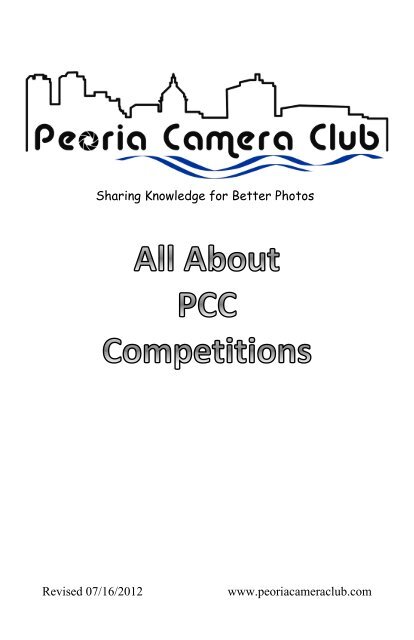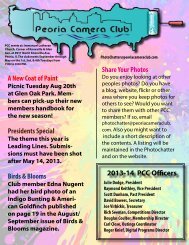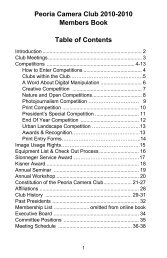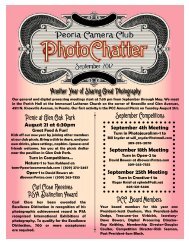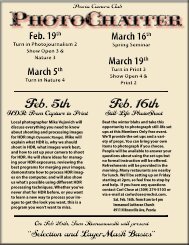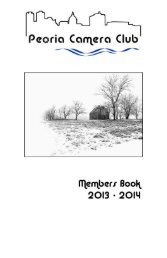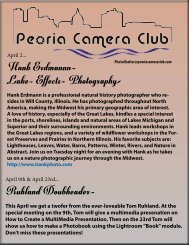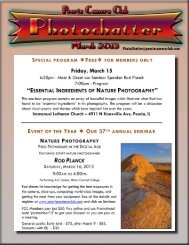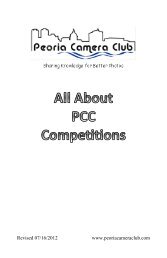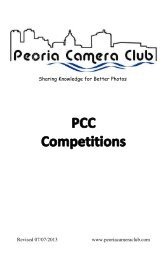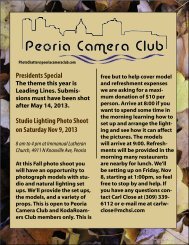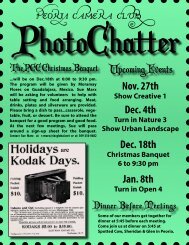Entering Print Competitions - Peoria Camera Club
Entering Print Competitions - Peoria Camera Club
Entering Print Competitions - Peoria Camera Club
Create successful ePaper yourself
Turn your PDF publications into a flip-book with our unique Google optimized e-Paper software.
Sharing Knowledge for Better Photos<br />
Revised 07/16/2012<br />
www.peoriacameraclub.com
Contents<br />
Basic Competition Process…………………………..…………… 1<br />
<strong>Competitions</strong> ……………………………………..………………. 2<br />
Competition Number ………………………………..……………. 2<br />
Judging …………………………………………………………… 2<br />
Image Manipulation Rules …………………….….………............ 3<br />
<strong>Club</strong>s within the <strong>Club</strong>…………………………………………….. 4<br />
<strong>Entering</strong> Digital <strong>Competitions</strong> ……………………..…………….. 5<br />
Digital Category Definitions……………………………………… 6<br />
<strong>Entering</strong> <strong>Print</strong> <strong>Competitions</strong>……………………..…….………….. 7<br />
<strong>Print</strong> Entry Form Sample ……………………….…….………….. 8<br />
Urban Landscape Competition (Digital)………….…………......... 8<br />
President’s Special Competition (Digital & <strong>Print</strong>s)…….…..…….. 9<br />
End of Year Competition (EOY)………………..………………… 10<br />
Awards and Recognition…………………………………...……… 11<br />
Image Usage Rights and Responsibilities………….….….…..…… 11<br />
Essentials for Exceptional Photos …………………………….….. 12<br />
Notes …………………………………………………………….... 13
This page is blank on purpose
1<br />
Basic Competition Process<br />
1. Read the included competition instructions.<br />
2. Decide which competition(s) you wish to enter.<br />
3. Shoot the images.<br />
4. Process the images. (See Image Manipulation Rules)<br />
5. For digital images, follow the rules for digital competitions<br />
and the category you are entering. Get them ready to enter<br />
by following the instructions under “<strong>Entering</strong> Digital<br />
<strong>Competitions</strong> & Rules”. Then put the images on a CD, flash<br />
drive or email.<br />
6. For prints mount them as specified in <strong>Entering</strong> <strong>Print</strong><br />
<strong>Competitions</strong>. ‘PRT”<br />
7. Look at the PCC Image Handler Chart in the Meeting and<br />
Competition Schedule insert to determine to whom you<br />
should give or email your entries.<br />
8. On or before the “turn-in date” listed in the club schedule,<br />
give or email your entries to the handler. If this is your first<br />
entry the handler will assign you a club number and tell you<br />
or email that number to you after the showing.<br />
9. Check for the date of the “showing” on the website or on<br />
the insert in this booklet and attend that meeting to hear<br />
the review of your entries.<br />
10. The handler will return your prints, CD or flash drive to you<br />
and record your results in club records after the showing of<br />
results. At this time the handler will also inform you of your<br />
club number.<br />
11. And finally and hopefully pick up your award at the showing<br />
or at a later date.<br />
12. The results of each competition will be posted on the club’s<br />
website under <strong>Competitions</strong>.
2<br />
<strong>Competitions</strong><br />
Throughout the year the <strong>Peoria</strong> <strong>Camera</strong> <strong>Club</strong> sponsors member<br />
competitions in digital projected images and prints. Digital categories are<br />
Creative, Nature, Open and Photojournalism. <strong>Print</strong> categories are Large<br />
& Small Color and Large & Small Monochrome Judge’s comments<br />
about each image are included when the competitions are shown at club<br />
meetings. The club also sponsors an “End of Year”, Urban Landscapes<br />
and a “President’s Special” competition in a variety of formats. The<br />
meeting program schedule clearly identifies turn-in and show dates.<br />
Additional special competitions may be organized by the program<br />
committee to give club members opportunities to compete in different<br />
and challenging ways. Entries in these special competitions and in the<br />
President’s Special are not eligible for the End of Year competition. The<br />
club’s web site and PhotoChatter newsletter will have information about<br />
any special competitions.<br />
The maker must have exposed all parts the digital image, negative or<br />
print used in any of the competitions. Members wishing to enter slides<br />
into a digital competition are responsible for converting them to digital<br />
images before entering them.<br />
Competition Number<br />
The first time a member enters a competition, he or she is assigned a<br />
competition number that is used to track all of the member’s competition<br />
results. The handler for that first competition will obtain a number from<br />
the Competition Director and inform the member of his or her number to<br />
be used in all further competitions.<br />
Judging<br />
An external judge in most instances will judge each entry.<br />
In print competitions, the judge will select the best 1/3 of the<br />
prints in each print category as “Acceptance” and will select a 1 st ,<br />
2 nd and 3 rd place in each print category.<br />
In Digital competitions the judge will select the best 1/3 of<br />
images in each club level as “Acceptance” and will select one 1 st ,<br />
2 nd and 3 rd overall in each competition. The maker will have an<br />
opportunity to hear the comments by the judge at the showing.<br />
After showing, the results will be posted on the club’s website. 1 st ,<br />
2 nd and 3 rd places will be announced in PhotoChatter.
3<br />
Image Manipulation Rules<br />
With the perception by some that digital photography is synonymous to<br />
digital manipulation, it is essential to address the ethics and “rules” of<br />
image manipulation. It is left to the photographer’s conscience and<br />
integrity to apply these rules.<br />
Creative ‘C’ and Open ‘O’ <strong>Competitions</strong><br />
Any and all post processing techniques are permitted in these two<br />
Categories. Prior to any altering, all parts of the entered image must be<br />
created by the maker.<br />
Nature ‘N’ and Photojournalism ‘PJ’ <strong>Competitions</strong><br />
The following post-capture processing with the aid of a computer and<br />
software such as Adobe Photoshop, within limits, will be acceptable.<br />
<br />
<br />
<br />
Selective Editing: Adjustments can be made selectively to your<br />
photo. Cloning, dodging, burning, etc. to improve your photo or<br />
remove imperfections or minor distracting elements, etc. is<br />
acceptable. However, using any editing tools to duplicate, create, or<br />
move major elements of your photograph are not permitted.<br />
Use of Adjustment Layers: Levels, curves, color balance,<br />
hue/saturation, and others so long as they do not create an<br />
unnatural look are acceptable.<br />
Miscellaneous: Borders, Sharpening, Cropping and Resizing are<br />
acceptable.<br />
<strong>Print</strong> ‘Prt.’ <strong>Competitions</strong><br />
Any and all post processing techniques are permitted in the four print<br />
Categories. Prior to any altering, all parts of the entered prints must be<br />
created by the maker.
4<br />
‘<strong>Club</strong>s’ Within the <strong>Club</strong><br />
For Digital competitions only<br />
In digital competitions, there are four groups known as ‘clubs’ through<br />
which members compete against one another. These ‘clubs’ are<br />
Regular, Bronze, Silver and Gold. New members join and compete in<br />
the Regular ‘club’ and as their skills improve, as demonstrated in digital<br />
competitions, they can advance to Bronze, to Silver and to Gold ‘club’<br />
levels. ‘<strong>Club</strong>s’ are not used in <strong>Print</strong> competitions, President’s Special or<br />
other competitions.<br />
Promotion to a higher ‘club’ is based on a specific number of images<br />
being accepted in competitions. An acceptance (point) means that the<br />
judge likes your photograph for its impact, composition, technical<br />
achievement, presentation and other factors related to photographic<br />
performance. For Creative, Photojournalism (PJ) and Nature it takes 10<br />
acceptances (points) to move from Regular to Bronze, 25 acceptances<br />
(points) to move from Bronze to Silver and 50 acceptances(points) to<br />
move from Silver to Gold. For the Open category it takes 15<br />
acceptances (points) to move from Regular to Bronze, 30 from Bronze<br />
to Silver and 60 from Silver to Gold.<br />
In each digital competition, one (1) point is awarded for each<br />
acceptance. Three (3) additional points will be awarded for the overall<br />
Best of Show image. Similarly, two (2) additional points will be awarded<br />
for the overall second place image and one (1) additional point will be<br />
awarded for the overall 3 rd place image. These extra points for first,<br />
second and third place images do not count toward the Kisner award<br />
described in the Members Handbook.<br />
There are no “clubs” in <strong>Print</strong> <strong>Competitions</strong>. For more information<br />
on print competitions, see <strong>Entering</strong> <strong>Print</strong> <strong>Competitions</strong>.
5<br />
<strong>Entering</strong> Digital <strong>Competitions</strong><br />
For all categories of digital images<br />
The files must be jpg and the file size should not exceed 1mb.<br />
Slides must be converted to digital before entering.<br />
Image size should be no greater than 768 pixels in height or<br />
1024 pixels wide.<br />
The images must be named with the following format.<br />
TITLE IN ALL CAPS by member name and member number<br />
.jpg. The TITLE portion of the file name should not exceed 32<br />
characters. Example; ROBIN WITH YOUNG ON NEST by<br />
Tom Trust # 99.jpg.<br />
Three images may be entered in each digital competition.<br />
The maker, prior to any altering, must create all parts of the<br />
image.<br />
Once an image is “Accepted”, the only other time it can be reentered<br />
in a PCC digital competition is the same category in<br />
the End of Year competition for the current club year<br />
Digital images can be turned in by CD or flash drive at a club meeting or<br />
sent by email to the appropriate image handler on or before the<br />
scheduled turn in date. (See <strong>Club</strong> Meeting Schedule insert and Image<br />
Handler insert)
6<br />
Digital Category Definitions<br />
Creative Images ‘C’<br />
A creative image stimulates a viewer’s mind to attempt to interpret the<br />
message being conveyed. While traditional photography depicts a<br />
subject as a reasonable facsimile of reality, creative photography<br />
depicts the subject through a substantial departure from reality. A<br />
creative photograph uses a variety or combination of non-standard<br />
capture or post processing techniques or controls to alter or distort<br />
reality. Some examples are computer-modified images, abstract<br />
patterns, impressionism, infrared, party lights, glassware, backlights,<br />
kodalith and filters.<br />
Nature Images ‘N’<br />
A nature image is restricted to the depiction of fact or phenomena from<br />
all branches of the natural sciences (botany, zoology, geology, etc.).<br />
Nature images must capture a natural subject in a way, which would<br />
allow a well-informed person to identify the subject and to also be able<br />
to certify its honest presentation. Human elements, if present, should<br />
be unobtrusive. Images depicting museum habitats, domestic animals,<br />
cultivated plants, or other subjects in any form that alters the truth of<br />
natural subjects are not eligible. The goal of nature images is to depict<br />
nature in its true and natural setting, without the presence and influence<br />
of humankind.<br />
Open Images ‘O’<br />
An Open image is more than a record of an object, person, event or<br />
place. It should characterize, enhance, or distill the essence of what is<br />
being photographed. It can be used to convey an idea, to make a<br />
statement, or to tell a story. Lacking these qualities, the image becomes<br />
just another snapshot or record shot. Technical Merit, Impact and<br />
Composition are critical in these images. Any image that meets the<br />
requirements of Creative, Nature and Photojournalism categories may<br />
also be entered in Open competitions.<br />
Photojournalism Images ‘PJ’<br />
An exceptional photojournalism image tells a story and stirs the<br />
emotions of the viewer. A photojournalism image may be a<br />
spontaneous, dramatic shot of a disaster, a death, or destruction. It may<br />
also be the excitement of a sporting event or a photograph depicting a<br />
subject of human interest. Although technical skills are important in any<br />
photograph, in photojournalism story-telling qualities are most important.
7<br />
<strong>Entering</strong> <strong>Print</strong> <strong>Competitions</strong> ‘PRT’<br />
<strong>Print</strong> Categories and Sizes<br />
Small color – (5x7 minimum up to 8x12)<br />
Large color – (over 8x12 up to 16 by 20)<br />
Small Monochrome – (5x7 minimum up to 8x12)<br />
Large Monochrome – (over 8x12 up to 16x20<br />
Mounting <strong>Print</strong>s<br />
Each print must be mounted on a rigid backing. (Foamcore, mat board<br />
or similar)<br />
<br />
<br />
<br />
<br />
<br />
5x7 prints must be mounted on 8x10 or 11x14<br />
Over 5x7 up to 8x12 must be mounted on 11x14<br />
Over 8x12 up to 16x20 must be mounted on 16x20 (16x20 prints<br />
may be flush mounted)<br />
<strong>Print</strong>s may be matted but frames or glass are not allowed.<br />
<strong>Print</strong>s on canvas are not allowed.<br />
All topics including Creative, Nature, Open and Photojournalism are<br />
eligible for any print category. All parts of the final print image must be<br />
created by the maker.<br />
Three prints may be entered in each category in each competition.<br />
All entries within each category are judged as one group.<br />
<strong>Print</strong>s may be printed using commercial or personal printing processes.<br />
All prints must be properly identified on the back of the print, in the<br />
upper left corner, when viewed from the back, using the Entry Form<br />
shown on the next page. The Entry Form may be duplicated from the<br />
separate insert in this booklet or printed from the PCC website.<br />
<strong>Print</strong>s should be turned in at the meeting(s) specified in the meeting<br />
schedule. Images turned in after that date will not be eligible for that<br />
competition. NOTE: If you would like your winning print shown on the<br />
PCC website or in PhotoChatter please include a low resolution jpg file.<br />
Once a print is “Accepted” the only other time it can be entered in a PCC<br />
print competition is in the same print category in the End of Year<br />
competition for the current club year.
8<br />
<strong>Print</strong> Entry Form Sample<br />
Highlighted are typical entries are needed<br />
<strong>Peoria</strong> <strong>Camera</strong> <strong>Club</strong><br />
<strong>Peoria</strong> <strong>Camera</strong> <strong>Club</strong><br />
<strong>Print</strong> Entry Form<br />
<strong>Print</strong> Entry Form<br />
Name & club # Jane Doe #13 Name & club # John Doe #1<br />
<strong>Print</strong> Title Things About Me<br />
<strong>Print</strong> Title All About Her<br />
Competition #<br />
2<br />
Award (entered by handler) Competition #<br />
3<br />
Award (entered by handler)<br />
Category<br />
Category<br />
Small Color S Monochrome Small Color X S Monochrome<br />
X Large Color L Monochrome Large Color L Monochrome<br />
Urban Landscape Competition ‘UL’<br />
(Digital)<br />
This digital competition features images about anything related<br />
to an urban setting such as structures in the form of buildings, bridges,<br />
streets, towers, bus shelters and so on, thus the definition is very broad.<br />
There is only one ‘UL’ competition on the schedule.<br />
Three entries may be entered as digital images only.<br />
Digital images must be JPEG files and be entered as described in<br />
“<strong>Entering</strong> Digital <strong>Competitions</strong> & Rules” in this booklet or on the club<br />
website.<br />
Images may be altered with post processing techniques according to<br />
the Digital Manipulation Rules for the Open Category on page 5 in<br />
this booklet or the club web site.<br />
Images must be turned in before or at the meeting(s) specified in the<br />
meeting schedule or emailed to the UL handler. Images turned in<br />
after that date will not be eligible for that competition.
9<br />
President’s Special Competition<br />
(Digital & <strong>Print</strong>s)<br />
An end of season a President’s Special Competition is offered in two<br />
formats: Digital and <strong>Print</strong>. Entries should be turned in at the meeting(s)<br />
specified in the Meeting Schedule. The images are judged during the<br />
first General meeting in May.<br />
All images in each format compete as a single group.<br />
The digital images format is judged live using electronic judging<br />
equipment to score the images. The current club president should, if<br />
possible, select three previous club presidents for judges.<br />
The prints are displayed and judged by popular vote of everyone in<br />
attendance at the President’s Special Competition General meeting.<br />
1/3 of the images in each format will be accepted. From those<br />
accepted: 1 st , 2 nd & 3 rd will be selected in each format. The judges<br />
select the Best of Show from the 1 st place images in each format.<br />
That Best of Show image is replaced by moving up the 2 nd & 3 rd place<br />
winners. Third place is not awarded for that category. 1 st , 2 nd & 3 rd<br />
place receive a ribbon. Best of Show receives a plaque.<br />
Entries in this President’s Special Competition are not eligible for the<br />
End of Year Competition.<br />
Entries in this competition count toward the Kisner Award.<br />
Images entered in this competition must have been exposed after the<br />
previous President’s Special competition showing. A member can<br />
enter five digital images and five prints; however each image may be<br />
entered in only one format. The same image cannot be entered as a<br />
digital and as a print.<br />
President’s Special Topics<br />
At the current years President’s Special Competition, the incoming<br />
president for the new club year will announce his/her choice of topic for<br />
the upcoming year’s President’s Special Competition.<br />
Some previous President’s Special Topics have been:<br />
Churches … Inside and Outside<br />
Speed<br />
Low Key<br />
Reflections
10<br />
End of Year Competition ‘EOY’<br />
An End of Year competition is conducted prior to the annual Awards<br />
banquet. This is an opportunity to re-enter prints and images already<br />
entered in competitions during the current year. New entries are not<br />
permitted.<br />
<strong>Competitions</strong> are conducted in the following 8 categories:<br />
Digital categories are Creative, Nature, Open and Photojournalism.<br />
<strong>Print</strong> categories are Small Color, Large Color, Small Monochrome and<br />
Large Monochrome.<br />
‘<strong>Club</strong>’ groups are not used in End of Year competitions. All images<br />
compete together in each category.<br />
PSA judges from other camera clubs or individuals of known<br />
expertise that are not associated with the club judge images live.<br />
1/3 of the images in each category will be selected as accepted<br />
images. 1/3 of the accepted images will be selected as honor<br />
images and one of the honor images will be selected as Best of<br />
Show.<br />
Best of Show is awarded in each of the 8 categories.<br />
Each Honor Image receives a ribbon or certificate.<br />
Each Best of Show image receives a plaque.<br />
Plaques are presented at the first General meeting in September.<br />
Entries in this competition do not count toward the Kisner Award.<br />
End of Year Entry Rules<br />
Images should be turned in at the meeting(s) specified in the Meeting<br />
Schedule.<br />
Five images may be entered in each category.<br />
An image may be entered in only one category regardless of how<br />
many categories it was entered in during the current club year.<br />
Images must be entered in the original category and format that they<br />
were entered in during the current club year.<br />
Both accepted and non-accepted images from current year’s<br />
competitions may be entered and must use the identical names as<br />
originally entered. Images from Special <strong>Competitions</strong>, such as Urban<br />
Landscapes, are not eligible for End of Year competitions.
11<br />
Awards and Recognition<br />
Awards are all about recognizing members for their work and<br />
performance within the club and also to encourage new members to<br />
compete thus advancing their skill levels. Ribbons, plaques and<br />
certificates are used as a means of congratulating and honoring these<br />
members for their achievements in the course of membership.<br />
The best awards and recognition happen when you enter a competition<br />
and a judge makes a constructive comment about your photograph.<br />
This becomes a moment of learning even for the most skilled members<br />
in the club. Whether or not the judging results in acceptances for your<br />
images, the competition process will help you improve your knowledge<br />
and skills as a still photographer.<br />
Image Usage Rights and Responsibilities<br />
Each submitter warrants and represents that each image was made<br />
by the submitter; the submitter is the sole and exclusive copyright<br />
owner of the image and the image will not infringe on the rights of<br />
third parties. This includes image parts that make up the final<br />
image.<br />
Each submitter agrees to release and hold harmless the <strong>Peoria</strong><br />
<strong>Camera</strong> <strong>Club</strong> (PCC) and its members, officers and directors from all<br />
liability, damages, cost or expenses of any kind which may occur in<br />
connection with any claims concerning the publicity rights,<br />
defamation, invasion of privacy, copyright infringement, trademark<br />
infringement, or any intellectual property related causes of action.<br />
Each submitter permits PCC to enter his/her images in<br />
Photographic Society of America (PSA) and Central Illinois <strong>Camera</strong><br />
<strong>Club</strong>s Association (CICCA) photo competitions and permits PCC,<br />
PSA and CICCA to use the images at meetings for educational or<br />
promotional purposes, in their publications and on their websites.<br />
The submitter retains all legal ownership rights to the image<br />
copyright. The use of images by organizations other than PCC,<br />
CICCA or PSA will require the consent of the submitter.
12<br />
Essentials for Exceptional Photos<br />
The following is a guide to get you familiar with the words used by<br />
judges as they review images.<br />
Impact is the sense one gets upon viewing an image for the first<br />
time. Compelling images evoke laughter, sadness, anger, pride,<br />
wonder or other emotions.<br />
Creativity is the external expression of the imagination to<br />
convey an original or fresh, idea, message or thought.<br />
Technical excellence is the quality of the image. Retouching,<br />
post processing, sharpness, exposure, printing, mounting, and<br />
correct color all speak to the qualities of the image.<br />
Composition is the design of an image to bring all of the visual<br />
elements together in concert. Proper composition holds the viewer<br />
in the image and prompts the viewer to look where the creator<br />
intends. Effective composition can be pleasing or disturbing.<br />
Lighting refers to how dimension, shape and roundness are<br />
defined and enhanced thru the use of light.<br />
Style is defined in a number of ways. It might simply be how a<br />
photographer applies light, composition, framing, color etc. to<br />
his/her images. It can have a positive impact when the subject<br />
matter and style are complementary..<br />
Presentation gives the image a finished look. Mats and borders<br />
should enhance prints and borders should enhance digital images.<br />
Center of Interest is the point or points on the image where the<br />
maker wants the viewer to stop as they view the image. There can<br />
be primary and secondary centers of interest or occasionally, the<br />
entire scene collectively serves as the center of interest.<br />
Subject Matter should always be appropriate to the story being<br />
told in an image.<br />
Color Balance supplies harmony to an image and can enhance<br />
its emotional impact. Color balance is not always harmonious and<br />
can be used to evoke diverse feelings for impact.<br />
Story Telling is the narrative property in a photo by which the<br />
photographer implies a specific story or encourages the viewer to<br />
develop their own story.
13<br />
Notes


